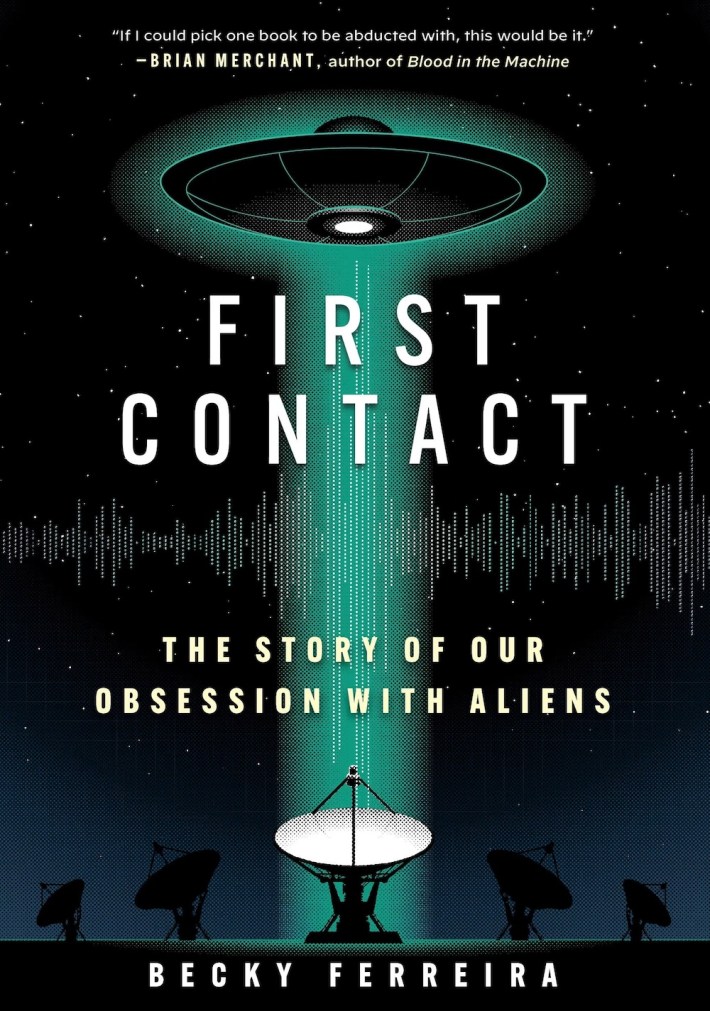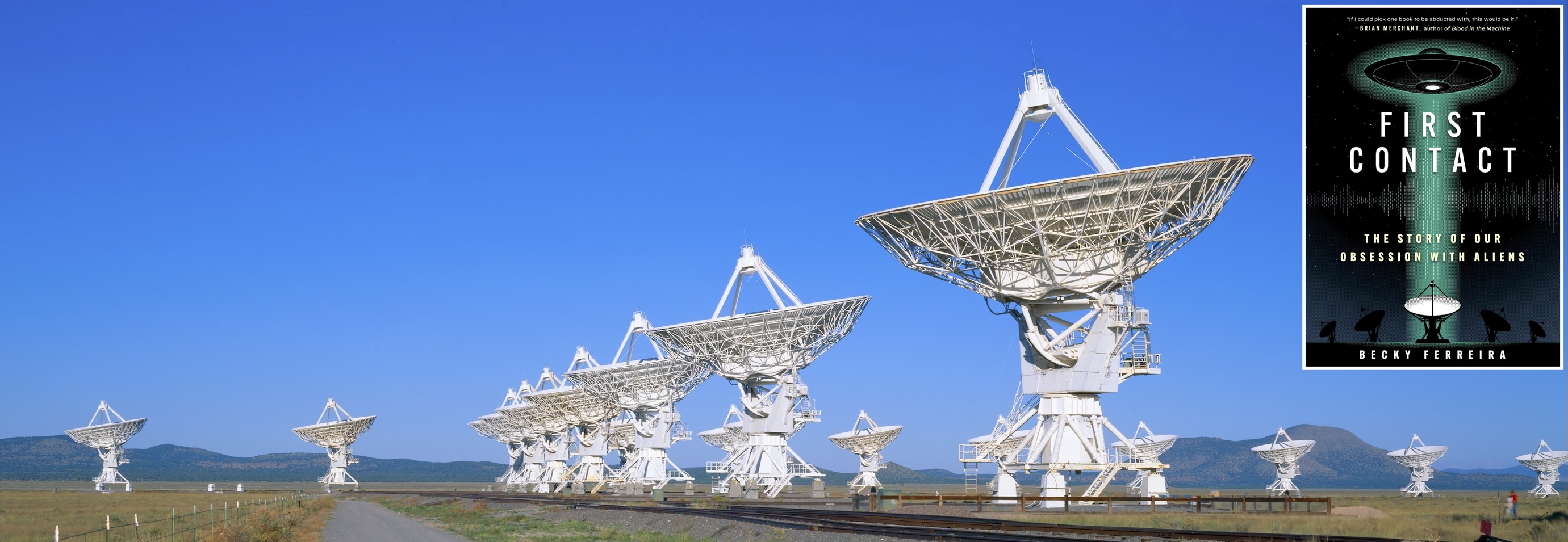In the balmy late summer of 1924, people across the world prepared to receive the first messages from the intelligent alien civilization that was assumed to inhabit Mars.
To tune in to these Martian communications, the U.S. military imposed a period of radio silence on the nation that spanned 36 hours between August 21 and 23, coinciding with an unusually close pass between Mars and Earth in their orbits around the Sun. Martians, so the reasoning went, might capitalize on this moment of relative proximity—when the planets were a mere 34 million miles apart, instead of many times that distance—to reach out to their neighbors.
“Now, if ever, we may solve the disputed question whether superman rove [Mars’s] crust,” wrote the journalist Silas Bent in the New York Times on August 17, 1924. Hopes were high for contact with a Martian civilization, sparking “stupendous interest” from a “credulous public” in the lead-up to the historic Mars opposition, wrote the Miami News.
In addition to declaring a National Day of Radio Silence, the U.S. military recruited Charles Francis Jenkins and David Peck Todd, a leading inventor and an astronomer respectively, to capture Martian missives sent across the interplanetary transom. For this purpose, Jenkins developed what he called a “radio photo message continuous transmission machine” that converted radio signals into optical flashes that could be recorded onto a 30-foot-long roll of photographic paper.
When the opposition arrived at last, Americans flooded public observatories, hoping to catch a glimpse of their Martian neighbors. Jenkins and Todd, meanwhile, looked for messages recorded by the contraption in Jenkins’s lab. The device did end up recording an inscrutable arrangement of dots and dashes, a result that tantalized the public, though Jenkins did not believe he had made contact with Martians.
“Quite likely the sounds recorded are the result of heterodyning or interference of radio signals,” Jenkins told the New York Times. “The film shows a repetition, at intervals of about a half hour, of what appears to be a man’s face. It’s a freak which we can’t explain.”
Other instruments turned up similarly puzzling results. An experiment in Dulwich, England, recorded “strange noises” early on the morning of August 23, which “could not be identified as coming from any earthly station,” according to an Associated Press report published later the same day.
In the end, the tests turned up no concrete proof of life on Mars, let alone a civilization more advanced than our own. But that didn’t sway public opinion much. People had been primed to believe in Martians thanks to a slew of purported evidence that had been championed by respected scholars in the decades leading up to the opposition.
Nikola Tesla, the polymath engineer, claimed to have intercepted Martian messages as early as 1899. In a splashy article published in a 1920 issue of The Tomahawk, Guglielmo Marconi, the Nobel Prize–winning engineer credited with inventing radio, also expressed hope that he had already made contact with aliens on Mars. And of course, the astronomer Percival Lowell was famously certain that he had spotted huge irrigation structures etched into the surface of the red planet, signaling the presence of an advanced, though possibly senescent, civilization. These observations were later determined to be optical illusions and perhaps some wish fulfillment on Lowell’s part.
Press coverage of the topic regularly wove in skeptical snippets from other experts, but far more ink was spilled on the anatomies and abilities of the Martians that probably, likely, all-but-certainly existed. During this wobbly moment in history, haunted by the traumas of unthinkable war and unrest, people looked to Mars, hoping for a more mature alien society, like children seeking elder guidance.
“If there are beings on Mars, in the similitude of human beings, they are an order of intelligence much superior to ours,” Silas Bent, the New York Times journalist, wrote in his preview of the Mars opposition. “Accepting that difficult premise, it is reasonable to suppose that the Martian knows much more about us than we know about him or his world, and it is interesting to speculate what he thinks of us, of our feverish struggle for a living, our vanities, our suicidal World War, our little gardens and our big deserts.”
In October 1938, an actor named Frank Readick was taking notes on how to report on an alien invasion.
He listened over and over to a broadcast from the previous year describing the Hindenburg erupting in flames and crashing on a New Jersey airfield, killing 36 of its passengers and crew members. The radio reporter Herbert Morrison’s live on-site coverage became iconic after the transoceanic vehicle spiraled into a catastrophic tragedy. Morrison, his voice shot through with horror at what he was witnessing, uttered the famous words “Oh the humanity!” as the microphone captured the screams and grief of the crowd gathered at the site.
The recording was Readick’s inspirational grist for an upcoming episode of the weekly radio series The Mercury Theatre on the Air, created and hosted by the 23-year-old wunderkind Orson Welles. The series dramatized classic literary works, and the October 30 broadcast would feature an adaptation of H. G. Wells’s War of the Worlds. Readick was cast as a reporter live at the scene where the invading Martians arrived in New Jersey, of all places, before he went radio silent as one of the invasion’s first casualties. He hoped to channel the surprise and panic of the Hindenburg broadcast as part of his performance. It’s fair to say, in retrospect, that Readick and his cast members really nailed their roles.
In fact, they were a little too good. Welles’s choice to format the drama as a fake news report convinced some listeners that hostile Martians were, in reality, marauding around the Eastern seaboard in search of fresh new human bodies to chug-and-crush like beer cans.
“The broadcast … disrupted households, interrupted religious services, created traffic jams, and clogged communications systems,” reported the New York Times on Halloween, the following day. The article described “a wave of mass hysteria” that included families fleeing homes and police stations overrun with panicked calls. Local officials reassured concerned members of their communities that the broadcast, despite its careful verisimilitude to real news bulletins, was a dramatization.
It was, indeed, all an imaginary affair—from Wells’s novel to Welles’s adaptation to the actual media reports of panic.
In the decades that followed the infamous broadcast, scholars have suggested that the accounts of hysteria and chaos were wildly overstated by the press, and that very few listeners had actually been fooled by the drama. But in a tale that sounds like it could be eerily grafted onto the modern era, the newspaper industry was experiencing devastating losses in advertising revenue to a new medium, radio, and had every incentive to launch a broadside against the credibility of its rival.
It is true that a small number of people were alarmed and critical of the fake news format. One listener filed an unsuccessful $50,000 lawsuit against CBS for causing “nervous shock,” and the Federal Communications Commission instructed radio networks not to use the format of fake news bulletins again. But the more serious accounts of hospitalizations and even deaths in the fallout of the broadcast have been debunked, while claims of “mass hysteria” are largely unsubstantiated.
The broadcast was, in retrospect, one of those perfect storms when seemingly unrelated forces converge together to tear a singularity of meaning into history. For years following the misadventure, it served as a premonition of how people might respond to an actual alien attack and seemed to spotlight the vulnerability of a credulous public. Today, it is a powerful example of how media coverage can dramatically distort both our immediate perception, and long-term collective memory, of a single event.
Welles’s broadcast is a fitting gateway into the fascinating question of how human civilization would respond to the discovery of alien life and what it might mean to our species to learn that we aren’t alone. We’ve imagined so many variants of first contact moments, but it’s not clear that any of them will prepare us for the real thing. In an era of media silos and rampant disinformation, any discovery of alien life will be refracted across an infinite regress of subcultural fun-house mirrors. So get ready for those post-detection grifts, because people will be hawking alien armor and cosmic protein pills within minutes of any confirmed contact.
Human history is full of examples of anthropological “first contact” moments between cultures that were separated by hundreds or thousands of years. Many people involved in the search for alien life look to these past encounters between divergent societies as a kind of preparatory guide for human contact with extraterrestrials.
The terminal station of this particular train of thought can be a rather drab place. After all, humans have this disturbing habit of murdering each other during such encounters. That’s not to say that two cultures have never established friendly relations at first contact, or learned to maintain peaceful coexistence over time. But we have, at best, a sketchy track record filled with fraught meetings that devolved into violence and exploitation.
Indeed, it has become especially common for scholars to point to European colonialism as the ultimate cautionary tale for a post-detection world, as Indigenous peoples suffered immense tragedy in the fallout of contact with Europeans. These analogies tend to cast figures like Hernán Cortez or Captain James Cook as the “alien” invader armed with advanced technologies, while Indigenous peoples embody humanity, vulnerable to annihilation. As the renowned physicist Stephen Hawking put it, “if aliens ever visit us, I think the outcome would be much as when Christopher Columbus first landed in America, which didn’t turn out very well for the Native Americans.”
It’s fair to assume that any aliens capable of showing up on Earth would be technologically superior to humans based solely on the capacity for interstellar travel. But would such beings be animated by the same kinds of imperial ambitions as Columbus or Cortez? Or would they spread a message of galactic connection and peace, as with human analogs like Jesus Christ or Sojourner Truth? Or would they just need Earth as a rest stop to touch some grass and do some yoga before heading back onto the galactic road, completely ignoring us?
In the absence of any information, it’s easy to make arguments for any possible motivation. Perhaps any civilization that can jump across stars must exploit planetary resources on a massive scale, a situation that could put us at risk of getting plundered. Perhaps a civilization smart enough to explore the galaxy is necessarily mature enough to avoid trampling the life-forms it encounters (one hopes). Or maybe aliens might favor a certain nation or ethnicity, leading to alliances that exacerbate or overturn current international power dynamics.
At the end of the day, the aims of any intelligent aliens we meet are likely to be completely opaque to us, and we may never establish any substantial understanding beyond awareness of each other’s existence. Kathryn Denning, an archaeologist and SETI researcher, has argued that these “direct contact historical analogies are likely to be useless” because of such ambiguities. In her view, they may actually cause harm because they can perpetuate and oversimplify real historical events that have been mangled by cultural and political biases.
In other words, we are still unearthing past perspectives that upend our traditional narratives of cultural contacts and their repercussions for the present. With that in mind, how can we possibly expect these slippery historical analogs to contextualize a discovery of alien life?
Probably we can’t. But the instinct to endlessly excavate new truths and angles about ourselves, both literally from the ground and figuratively from our brains, is itself a worthy end.

Adapted from FIRST CONTACT: THE STORY OF OUR OBSESSION WITH ALIENS by Becky Ferreira. Copyright © 2025. Used with permission of Workman Publishing, a division of Hachette Book Group. Order it here.







